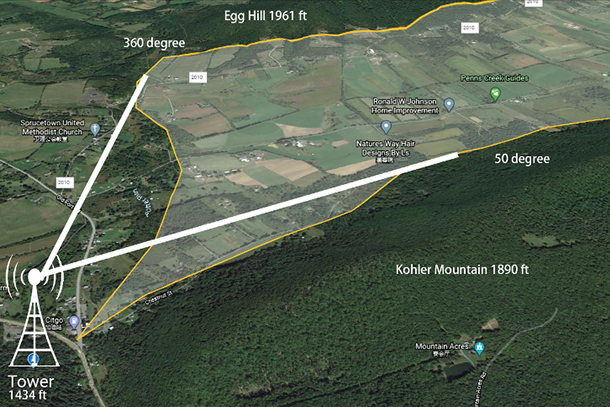
The team's solution would use a tower located on the top of a hill in Potters Mills that is at 1,434 ft mean sea level to transmit broadband internet. IMAGE: PROVIDED
Students explore solution to create a reliable broadband in rural communities
5/19/2020
By Samantha Chavanic
UNIVERSITY PARK, Pa. — In rural communities across the United States, delivering reliable broadband internet to customers remains problematic for service providers. Financial, geographic and technical components each present unique challenges to overcome. As part of a semester-long project in their EDSGN 558: Systems Design course this spring, Penn State engineering graduate students worked to define a low-cost rural internet solution for Georges Valley, a rural area about 10 miles east of State College.
Course instructor Sven Bilén, head of the School of Engineering Design, Technology, and Professional Programs and professor of engineering design, electrical engineering and aerospace engineering, challenged his students to design a system to provide reliable broadband access in rural areas. Centre County, which includes the Allegheny Plateau, Allegheny Front, Ridge and Valley regions and several wide valleys with rolling terrain, serves as an excellent example of the geographic challenges found in rural regions. With large ridges on either side and a deeply furrowed valley floor, Georges Valley and its approximately 400 residents appropriately represent the small-town American community without access to fast, reliable broadband. Currently, Georges Valley residents rely on satellite or mobile networks.
“Federal, regional and local governments have recognized this ‘digital divide’ and are looking for cost-effective ways to address it,” Bilén said. “This need became even more apparent and urgent with the rapid shift to remote learning and remote work as a response to the global pandemic. While many people in cities are finding adequate internet access to make this possible, most rural communities remain disconnected, or are underserved at best.”
As part of one large systems design team, the students in the class worked all semester on this challenge, led by a project leadership team comprised of project manager Todd Spurgeon, additive manufacturing and design graduate student; systems lead Nate Watson, additive manufacturing and design graduate student; business team lead Leen Abubaker, engineering leadership and innovation management graduate student; and technical team lead Daniel Henneh, engineering design graduate student.
Their proposed solution leverages “TV white space” to create a reliable broadband system. It uses idle TV channels within the VHF and UHF radio spectrum, or TV white space, to provide broadband internet to rural areas. The switch from analog to digital TV has freed up portions of the broadcast spectrum, allowing it to be used for other purposes. The benefits of using TV white space include minimal new infrastructure, transmission distance and capabilities and modest capital investment.
“This approach was chosen because, compared to other methods of providing internet to rural areas, it is more affordable, less susceptible to land topography and obstacles, yet is capable of providing reliable data speeds to the clients,” Henneh said.
Currently, use of TV white space is limited because of federal regulations. Spurgeon explained that TV white space is traditionally owned by broadcasting companies and the Federal Communications Commission (FCC) has been reluctant to open up this part of the spectrum for internet use.
“This spectrum is underutilized in these rural communities, and the population density does not lend it to commercial viability,” he said. “An opportunity presents itself for a minor change to legislation or FCC rules to permit the use of TV white space for rural broadband exclusively for populations where other solutions are not commercially viable.”
Watson explained that TV white space’s transmission capabilities — distance and through obstacles — allow for non-line-of-sight transmission, something extremely important in Georges Valley, an area with challenging terrain.
“If line-of-sight access is required, then many more towers are needed, which then need to be built and serviced, increasing the cost above what rural, low-density populations can afford,” he said. “The TV white space transmitters and receivers would be able to be placed on existing towers with existing connections to fiber optic cables with access to the internet.”
When the team first began working on the project at the beginning of the semester, members had no idea just how relevant their project would become. Months ago, lacking a reliable internet connection may have meant not having a stable video chat or issues with watching a movie on a streaming service. Now, during the COVID-19 pandemic, rural areas have limited access to the tool that lets children attend class and submit homework and adults work from home.
“The lack of reliable, high-speed and affordable internet services limits the success of rural communities because it directly affects their access to educational and economic resources,” Abubaker said. “People living in rural areas have the right to have the same service quality that enables them to complete their daily tasks and guarantees receiving an income [and] their continuous personal and professional development.”




